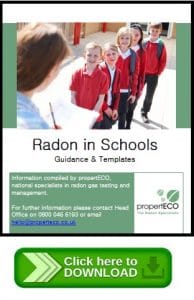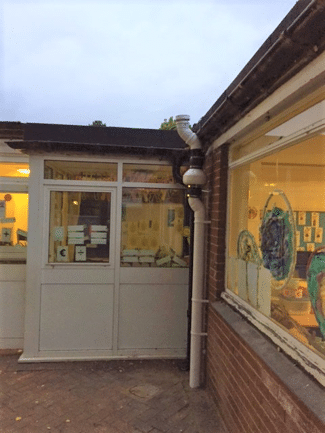 Radon is a serious issue throughout the UK, and if you are in the position of owning or managing a workplace property, you need to make sure that you have completed a radon risk assessment. This includes all schools.
Radon is a serious issue throughout the UK, and if you are in the position of owning or managing a workplace property, you need to make sure that you have completed a radon risk assessment. This includes all schools.
Radon can be a threat to any individual’s health, so it’s vital that it be taken seriously in schools. Read on to learn what radon is, how it might affect your school and what steps you can take to safeguard against radon’s harmful effects.
Radon is a radioactive gas that is both colourless and odourless, meaning that it cannot be detected by humans even if they are breathing it in.
Radon can be found anywhere in the UK. Some areas are more at risk than others; you can check how likely it is that your property will be affected by checking the radon map, but these are indicative only and cannot tell you whether your individual property is affected.
Radon is formed when the radioactive element uranium that is found in the rocks, soil, and earth beneath us breaks down and eventually turns into a gas. This gas rises out of the ground and if released in an outdoor space, is harmless as it is quickly diluted to very low concentrations.
However, if high levels of radon rise into a property, then the inhabitants are at risk of developing serious health problems as a result. Long term exposure to radon is the leading cause of lung cancer in non-smokers. That’s why it’s so important to test properties for radon.
 Anyone with lungs can get lung cancer, and long-term exposure to high levels of radon increases that risk.
Anyone with lungs can get lung cancer, and long-term exposure to high levels of radon increases that risk.
Teachers and other staff working in the school have a right to a safe workplace, which is why there is legislation in place to require radon risk assessments to be carried out.
Children are also at risk, and some scientists believe that radon exposure during childhood is even more dangerous than for adults. Whilst long term exposure to radon is harmful to everyone regardless of age, Canadian professor and expert in genome damage caused by radon Dr Aaron Goodarzi says, “Exposure to radon during childhood significantly increases the risk of developing lung cancer later in life. Indeed, childhood (ages 0–17 years) exposure to even moderately high radon concentrations (400 Bq/m3) is equivalent to a lifetime exposure at 100 Bq/m3 radon concentration. Thus, while it is advisable for anyone to test their homes and workplaces for radon (and mitigate if a problem is detected), any homes, schools, and childcare centres where small children and young adults spend a great deal of time should become a priority for radon elimination.”
The amount of time that children spend in school is significant and nowadays made even longer with the addition of breakfast or after school clubs and other activities.

Checking your school’s radon levels should be the very first priority you set when it comes to protecting your school against radon.
In fact, there is legislation already in place stating that every school must demonstrate that they have considered radon in their risk assessment. The Health & Safety Executive (HSE) can and will enforce radon testing where it is required, and even have a team of radiation inspectors who visit workplaces to make sure that a radon risk assessment has been completed.
HSE have recently contacted around 100 schools in a single local authority area having been made aware of very high concentrations being found in one school. In their communication with the schools, the HSE inspector requested evidence of a risk assessment having been completed and if it had not yet been done, gave a deadline for when it should be submitted.
In July 2023, a school was prosecuted by HSE for failing to protect staff and pupils from exposure to high concentrations of radon. The school was fined £50,000 and ordered to pay almost £20,000 in costs.
For any school that is located in a designated radon affected area (where it has been estimated that 1% or more properties will be affected), radon testing must be carried out to measure the risk. Testing must also be carried out of the school has a basement or cellar, regardless of geographic location.
Testing is simple and is typically conducted using passive radon detectors that are placed around the school for a period of three months. PropertECO can advise on how many detectors are required; depending upon the overall size and layout of the building this usually equates to around one in every three ground floor rooms.
Detectors should be placed between one and two meters above the floor. To avoid tampering or interference from pupils, they should be placed in supervised areas and ideally attached to shelving, conduit or notice boards so they cannot be easily removed or lost.
When the three-month testing period is completed, the test kits need to be returned to a laboratory for analysis. PropertECO use a third party independent lab that is validated by the UK Health Security Agency (formerly Public Health England), and our results reports are normally issued within ten working days.
There are various ‘action levels’ that relate to radon concentrations in school – some of which are enforceable and some which are advisory.
300 Bq/m3 – if radon concentrations exceed 300 Bq/m3 the “workplace action level”), steps must be taken to reduce the exposure that staff and pupils receive. This is a legal requirement set out in the Ionising Radiations Regulations 2017 and is enforceable by HSE. Reducing exposure can be achieved either through restricting access or by engineered means to lower the radon concentration. Restricting access is often impractical, so radon mitigation work is the most viable option for most schools. A Radiation Protection Adviser (RPA) must be consulted if concentrations above 300 Bq/m3 are detected so that a formal radiation risk assessment can be produced. propertECO work with several third-party RPAs across the country who can provide this service.
200 Bq/m3 – this is the residential “action level”. The UK Government advises that radon concentrations do not exceed this threshold in homes. The UK Health Security Agency (formerly Public Health England) recommend that schools adopt this action level, however this is only a recommendation and is not enforceable.
100 Bq/m3 – referred to as the ‘target level’, this reference level was introduced in 2010 by the Health Protection Agency (now UKHSA) as “the ideal outcome for remedial works”. They also advised that “The Action Level and Target Level should be applied to non-domestic buildings with public occupancy exceeding 2000 hours per year and to all schools.” This remains guidance only.

If your radon test has revealed elevated levels, you can arrange for a radon survey to decide on the best course of action to lower your school’s radon levels. One of our specialists will visit your school and based on the results of the radon tests, as well as the layout of your school, will decide what method will be effective in lowering radon levels.
One method to reduce radon is the installation of a radon sump. A radon sump is a small void created beneath the floor slab of the building, which acts as the lowest point of pressure. The gas will naturally be drawn towards this void and can be safely vented away using pipework and an inline fan. Depending on the school size and layout, and radon concentrations present, more than one sump may be required.
Another form of radon mitigation is the use of a positive input ventilation system. These systems work to increase the air pressure within a property, so that the normal ratio of air pressure you would find in a property compared to that in the ground Is reversed.
The positive input ventilation system does this by filtering in fresh air from outside into your property. This inhibits radon from being drawn into the building.
Positive ventilation systems have a few other benefits as well that make them a suitable fit in schools. For example, allergens such as dust mites will be reduced as a side effect, as well as the overall indoor relative humidity which is good news as these are both major aggravators of asthma.
Our expert teams can install both forms of radon mitigation, and sometimes a combination of both is required. The work itself can be scheduled around your term times, with disruption kept to an absolute minimum and timescales depending on the amount of mitigation needed.
Once you have had your radon mitigation system installed, you must regularly review your risk assessment to ensure you remain aware of the current radon levels in your school. It’s important to repeat the test at least once every two years and to ensure that the mitigation systems and working correctly.
Our team can arrange a schedule with your school to not only conduct radon testing after the installation of your radon mitigation system, but also to keep your radon sump or positive input ventilation in perfect running order.
These maintenance schedules are an important step in ensuring the continued safety of those within the school from rising radon levels, with our team capable of diagnosing and identifying faults in your school’s radon mitigation that might have gone unnoticed otherwise.
PropertECO have assisted many schools across the country in meeting their radon risk assessment obligations. We offer a ‘place and collect’ service alongside our radon detectors, meaning that we can ensure detectors are placed in the most appropriate locations to give reliable results.
If you would like advice on completing your radon risk assessment or guidance on how many detectors you require, please Contact Us. We recommend that you download our FREE Radon in Schools: Guidance & Templates document, including a template radon risk assessment for schools.
If you have already completed a test and need to discuss mitigation options, get in touch with us on 0800 046 6193, or contact us online.